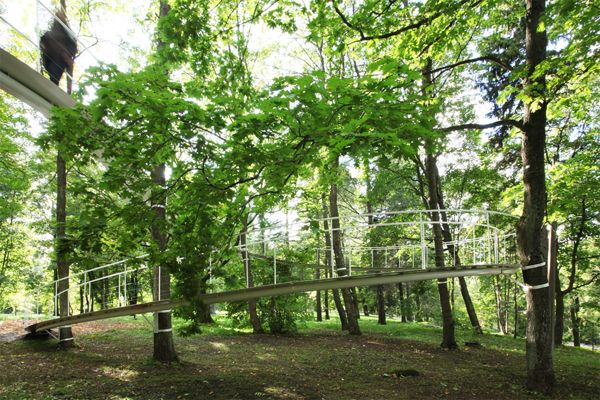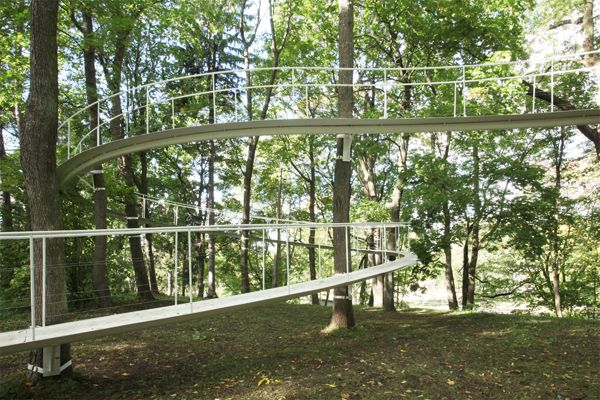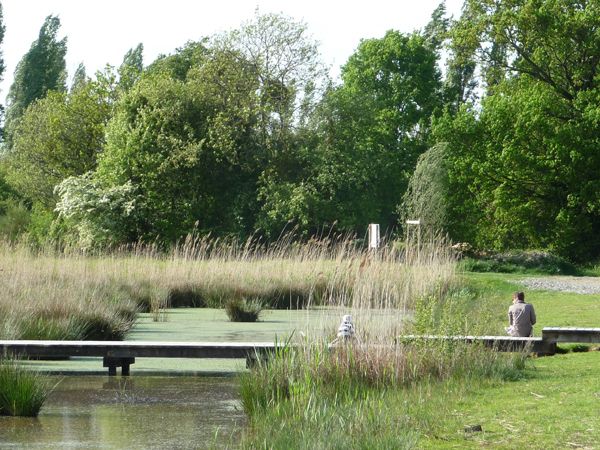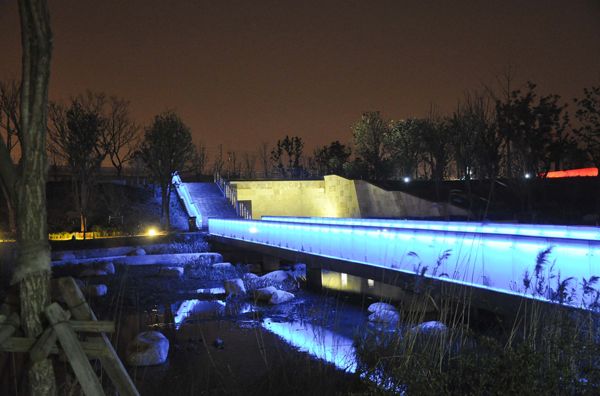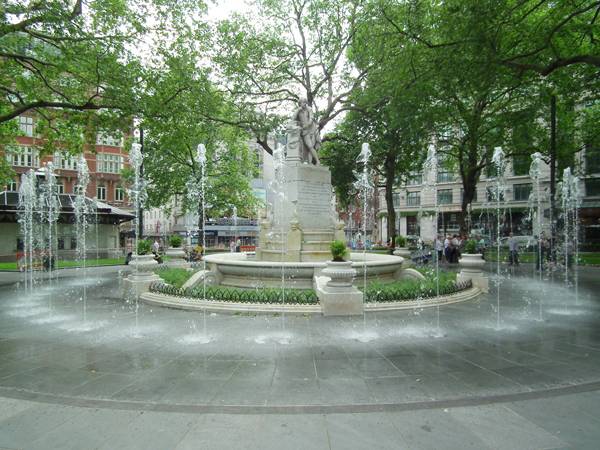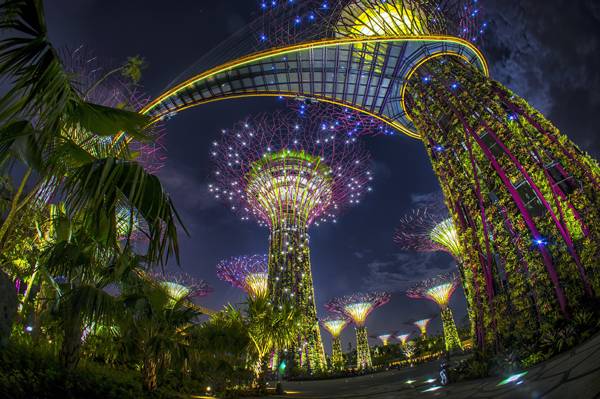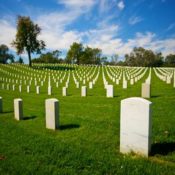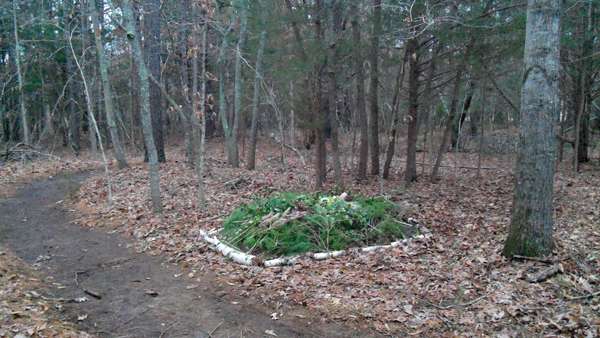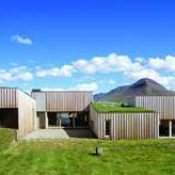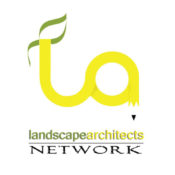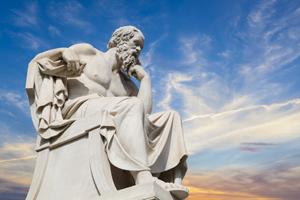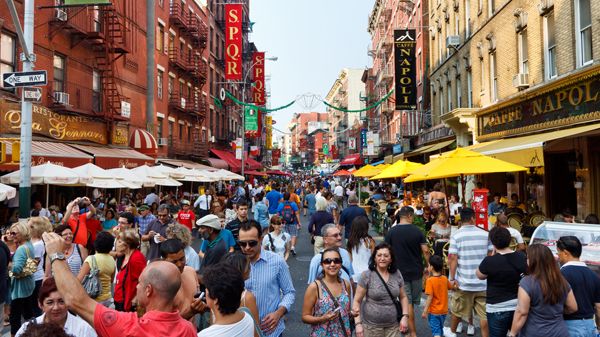Author: Land8: Landscape Architects Network
A Path in the Forest: Tree Top Walk Creates Awesome Forest Experience
A Path in the Forest is an incredibly beautiful and elegant installation making its way through the trees up to the sun in a park in the heart of the city of Tallinn, Estonia. It was created by Tetsuo Kondo Architects, a Japanese firm, as part of the urban installation festival LIFT11. The festival was one of the activities offered by the City for European Capital of Culture in 2011. A set of artistic, architectural, and landscape design projects was put together to enrich the surrounding environment and create new experiences for citizens. The company presented a similar spiral path at Architecture Biennale in Venice, but this iteration is slightly different. The Estonian walk takes the visitor through an indoor cloud artificially created from three layers of air pumped into the space. The architectural studio puts the human common perception of the surroundings under question.
What is LIFT11 LIFT11 is a festival featuring 11 urban installations. They are selected through a design competition, which Kondo won. The studio was invited to create the path. The 95-meter-long walkway is situated in a beautiful forest known as Kadriorg. Trees have grown there for more than three centuries, making it a majestic landscape. The elevated path was crafted from 139-millimeter steel pipe and a thin steel sheet that weaved among the trees, ultimately not using a single column. This design of the tree top walk detail gives visitors the opportunity to see the forest from another perspective. Instead of looking from the ground up, the path takes the viewer amidst the overstory of the tree canopy. Undoubtedly, a pleasurable experience! It is an invitation for humans to investigate further, to feel something new, to examine nature in a different way. It is truly a harmonious project between nature and structure, in the sense of its creation and shape. The installation doesn’t stand for itself, as a piece of art, but instead elegantly underlines the natural beauty. Despite its charm and success, the installation was temporary for the festival. But it is an inspiring example that can be repeated or reinvented, a fine solution that provides a way to give identity to an urban park, to make it more attractive for curious citizens. Boomkroonpad: Tree Top Walk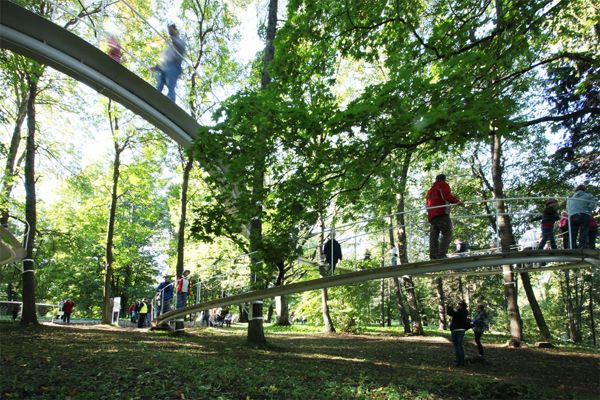 A Path in the Forest; credit: Tetsuo Kondo Architects
A Path in the Forest; credit: Tetsuo Kondo Architects
The idea of a tree top walk above the forest is actually not new. “The treetop” Boomkroonpad is a tourist attraction and part of an educational theme park in the Dutch province of Drenthe. Visitors can walk a 125-meter-long trail above the treetops and climb spiral staircases in order to experience incredible panoramic views. Nevertheless, these projects have a common ground: gaining knowledge. The call is for new experiences, for breaking the patterns, for reinventing the surroundings to make them better, and for adding new value. The designer said it best: “It is a piece of architecture which exists for the woods as the forest exists for the architecture. We cannot change the form of the forest, but we think the various elements in a forest can become one entity in this condition. “I hope that we can experience a forest, architecture, and an environment which we do not know yet.” Have you encountered similar walks high in the trees? Article written by Slavyana Popcheva Featured image : A Path in the Forest; credit: Reio Avaste all other images courtesy of Tetsuo Kondo Architects
Is Detroit turning into an Urban Forest?
The city of Detroit could soon look much less like a city, and much more like a wilderness bringing to life an urban forest. Due a high concentration of vacant properties, it has long served as a palette for designers to test large scale interventions in an aging urban core. Only recently has one of the many proposals start to come to life. Locally based Hantz-Woodlands has reached a deal with the State of Michigan to purchase 1,500 parcels of land for $500,000, with the intent of planting an urban forest on what is now mostly a vast landscape of abandoned homes and overgrown weeds.
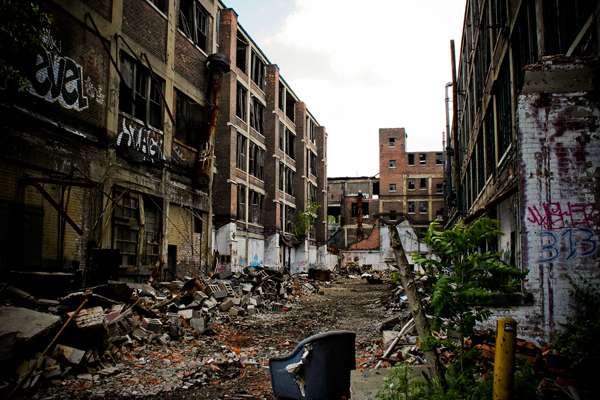
DETROIT, MICHIGAN – NOV 21: Abandoned Packard factory ruins on a sunny afternoon on November 21, 2012. Abandoned in 1958, the buildings still stand in a decayed state of beauty; image credit: Atomazul / shutterstock.com
The revolutionary urban forest
The project will take place in the Indian Village Neighborhood on Detroit’s southeast side. Within the perimeters of the project (Van Dyke to the west, St. Jean to the east, Mack to the north and Jefferson to the south) there are 180 city-owned vacant homes. What differentiates the Hantz-Woodlands project from some of the other outside groups is their commitment to invest and improve the neighborhoods, not only from a personal standpoint, but part of their new contract. Hantz employees have already begun regularly mowing overgrown lots, inspiring nearby homeowners to get involved as well as take better care of their own property. The plan is to be carried out in the next 2 years, with intent to demolish at least 50 vacant homes, and plant entire blocks with hardwood trees. The trees selected are mostly Oak, Maple and Poplar, so they will reach full maturity in roughly 50 years, proof that this project is truly an investment rather than temporary relief.
You may also like our Top 10 Sacred Trees, which includes oak and many more great specimens. Transforming the city into an unique landscape None of these planted zones will be private or fenced off, but rather open to the public. The hope is that the people in the community will transform and adapt the spaces to fit their needs- the trees are simply a framework. Although residents are encouraged to help maintain the new green space, Hantz will cut the grass regularly and ensure proper growth of the trees for the duration of the project. Some critics of the project have questioned why more isn’t being done in terms of creating a productive landscape for urban agriculture. Proponents say that the concept of urban food forests, as found most notably in Seattle, is not feasible in Detroit for several reasons. The pros and cons of an urban forest A large amount of the soil is contaminated from industrial waste, and the climate is much more frigid than that of the northwest, eliminating many of the options found in Seattle. In fact, Hantz-Woodlands is itself a faction of the larger organization Hantz-Farms, whose main focus is…you guessed it… urban agriculture. In Detroit, however, they have opted for a different approach that would focus more on solving social and environmental issues, although it is a goal to implement food systems if possible. The plan would create grassy lawns shaded by clean rows of trees, with the intent to provide safe, visually appealing parcels of land that had previously been dangerous eyesores. Below: Hantz Farms: Detroit’s Saving Grace Detroit has seen countless proposals due to its status as the poster child of dying industrial cities of the Midwest. Architects from all walks of the profession have had a hand in putting forth new ideas to reinvigorate a city that has become a shell of itself. All this interest has seemed to finally result in tangible results, and perhaps the tables have turned, with the city now serving as a positive example for others. Officials from Cleveland and Indianapolis have taken an interest in the project, proving that once someone takes that bold step of turning a plan into reality, others take note. Article written by Peter Salamon. Featured image: Atomazul / Shutterstock.comTop 10 World Class Landscape Architecture Projects of 2013
As 2013 grinds to a halt, it only seems fitting that here at LAN we sit down and take stock of the year gone by. With such a slew of world-class landscape architecture projects — either freshly consummated or procuring maturity through phases of design implementation over time — choosing only 10 was no easy feat. With an emphasis on waterfront revitalization and urban greening, here are the top 10 projects of 2013. 10. Victorian Desalination Plant Green Roof,Bass Coast, Australia This 26,000-square-meter piece of land art minimizes the dominant visual impact of the seawater processing plant along Australia’s Bass Coast. With no established green roof industry in Australia, no strict standards needed to be adhered to when designing the roof. The roof showcases key principles of water-sensitive urban design and represents the potential that green infrastructure has in realizing energy reduction through increased thermal performance, carbon sequestration, and reduction in carbon concentrations. 9. Ceramic Museum and Mosaic Park- Jinzhou, Dalian, Liaoning, China by Casanova + Hernandez Architecten
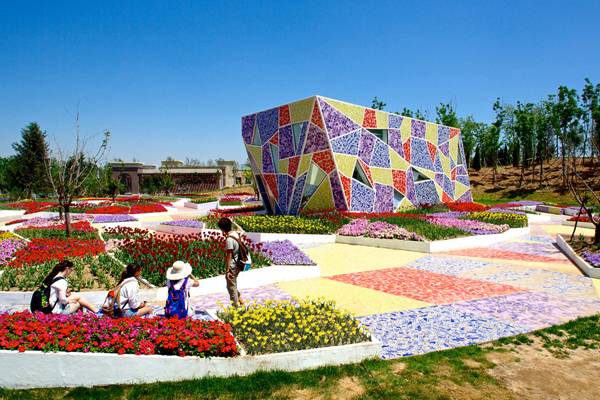
Jinzhou Museum and Mosaic Park in Jinzhou, China; image courtesy of Casanova + Hernandez Architecten
The Landscape of Death and Green Burial – How Our Beliefs Design Cemeteries
For countless generations, humans have disposed of their dead in the landscape — in churchyards, burial grounds, and cemeteries. The design of these “deathscapes” can tell us a lot about the cultural Zeitgeist of the time. The earliest human burial is thought to date back nearly 350,000 years ago. Since this time, every human culture has disposed of their dead in the landscape in a variety of ways. With the world population now in excess of 7 billion, we take a look at how the landscape can accommodate our dead in a sustainable way. Landscape, design and death The method of burial or commemoration of the dead, and the design of burial grounds, can tell a lot about the culture of the deceased and their generation. In western culture, we are influenced by a Christian heritage, living in what could be described as a post-Christian culture. This has inevitably influenced the design of our cemeteries.
In Christian culture, death is seen as a transfer of the spirit to the afterlife. Key to the method of burial in Christian cemeteries and churchyards is the belief in the resurrection of the flesh, come judgment day. This inevitably influences the design and form of the graveyards. For example, all Christian burials face east (the direction believed to be from where Christ will come again) and are located within consecrated ground such as churchyards. Therefore, the most logical spatial arrangement is to orientate the burial plots in rows. This gives rise to a formal, rectilinear, design. The legacy of this rectilinear design can be seen in many secular post-Christian, interdenominational cemeteries such as Arlington National Cemetery, a military cemetery.
During the Victorian period in the U.K., dynasty and remembrance began to dominate the landscape of death, with elaborate decorative tombstones and monuments intended to communicate the wealth, affluence, and status of the deceased, as exemplified in the infamous Highgate Cemetery in London.
What is a green burial?
Presently, there is a growing trend in the west for Green Burials. With the increasing focus on minimizing one’s carbon footprint during life, many people are turning to natural burial practices as a way of demonstrating their eco-credentials. In a similar way to the Victorian burials’ attempt to communicate the affluence and status of those interred, nowadays many people are interested in what the next generation will think of the way they treated the environment.
In many ways, Green Burial makes a lot of sense. According to the Casket and Funeral Association of America, 70,000 m3 ofhard wood, 90,272 tons of steel, 2,700 tons of copper and bronze, and 3,130 m3 of embalming fluid are buried through traditional burials every year — a substantial drain on limited assets! Cremation also takes its toll on the environment. Statistics from the Cremation Association of North America show that it can take two to four hours at temperatures ranging from 760 to 1,150 degrees C to fully cremate a body. This is estimated to be roughly equivalent to the energy required to drive 4,800 miles, or 7,725 kilometers. Added to this are the considerable toxins that are released into the atmosphere during cremation, such as carbon dioxide, lead, nitrogen oxide, and hydrogen fluoride (to name but four).
The practice of a Green Burial
Green Burial involves the interment of the body without embalming, using natural coffins or caskets to enable the body to decompose naturally, returning its nutrients to the ground. The aesthetics of Green or Natural Burial Grounds often reflect the environmental choices made by the interments. Gone are the rigid formal lines and large tombstones, in favor of woodlands, meadows, and open fields, as can be seen in sites like Binningwood, Westall Park, or Prairie Creek Conservation Cemetery.
This paradigm shift in our deathscapes has further reaching consequences though, as we gradually change our perception of the landscape of death and remembrance. In her article Cemetery Park, Sonia Jackett examines how St. George’s Field in Leeds has been transformed from a cemetery into a public park, while Southern Cemetery in south Manchester (the U.K.’s largest cemetery) has been designated a National Nature Reserve for its biodiversity.
Deathscapes for the 21st century will inevitably depart from the rectilinear form-language of the post-Christian typology to a more naturalistic form, and, like Cemetery Park and Southern Cemetery, will have to fulfill a multitude of functions, from providing space for relatives to mourn to performing green infrastructure functions such as habitat, biodiversity, and public recreational space. While there is currently a dichotomy between traditional cemeteries and natural burial grounds, the future may see the lines between these two typologies blur, and as seen with St. George’s Field, old cemeteries may even be overhauled to meet 21st century needs.
Find out more about Green Burials at www.finalfootprint.com Recommended Reading:
- Graceland Cemetery: A Design History by Christopher Vernon
- Stories in Stone: A Field Guide to Cemetery Symbolism and Iconographyby Douglas Keister
Article written by Ashley Penn Return to Homepage
4 Organic Additions You Can Make to The Lawn in The Winter
It’s a common misconception that homeowners don’t need lawn maintenance as much in the winters as they do in the summers. In fact, improper maintenance can lead to snow mold and other lawn diseases, while the fallen winter leaves can smother the aesthetic appeal of the grass and flowers. The cold season also reduces the soil’s natural capacity to eradicate weeds and increase the green on the turf, which also requires the use of herbicides and fertilizers to keep things running. But with a proactive approach, you can make the lawn disease-free and maintenance free as well as prepare it for the season ahead. And the best part… You can contribute to nature while maintaining the lawn with these 4 organic additions below: 1. Start seeding Winter is the time to fix up the bare patches because the grass plants will have ample time to grow into a healthy root line that will transition from the winter into the spring season. If your lawn has one of the warm grasses like St. Augustine, you can also place extra winter grass seeds. This is because the warm grass usually loses color and becomes inactive in the winter, so winter grass seeds will make sure you have green grass throughout, until the lawn is covered by snow. 2. Harvest some fruit Growing fruit on your own trees in the winter is one of the most satisfying lawn care activities for homeowners. Apart from new trees, you can also prevent the congestion and loss of productivity in the existing trees by pruning: mainly for apple trees. However, it’s not as simple as it sounds, because there are a lot of factors that come into play, such as the ability of the lawn to withstand the new plantation, the health of the soil etc. Moreover, looking at the selection of apple trees from Willis Orchards, you can see there are several varieties. Therefore, you’ll need to understand the condition of your lawn to determine its fruit planting ability and then decide on the type you want to grow. 3. Use eco-friendly fertilizers Eco-friendly fertilizers utilize natural nutrients so they don’t promote acidity in the run off or soil. The food web of the soil stores them until they are required by the plants, promoting a sustainable lawn over the next few months. You can combine the use of eco-friendly fertilizers with organic matter and use compost to top dress the soil. While you may find it difficult to spread the compost, the results will make it worth the extra effort–or you can use compost tea, which is easier to spread. Don’t waste organic fertilizer on clover, dandelions and other broad-leaf weeds: remove them with bare hands. 4. Keep the clippings, but get rid of the extra thatch There’s a difference between thatch and clippings, and thatch doesn’t result because of the clippings. The reason you should retain clippings in the winter is that it contains 90% of water, and allows the nutrients to return to the soil. On the other hand, thatch becomes a barrier for air, water and nutrient so the soil’s health is comprised. Some thatch on the lawn is acceptable. How do you provide for your lawn during winters? Feel free to leave comments. Article written by guest writer Brooklyn Williams
The 10 Stages of Being a Landscape Architecture Student: GIF party part 2
We know you all enjoyed our GIF party part 1 Life as a Landscape Architect; now here’s our second addition The 10 stages of being a landscape architecture student.
Being a student is hard, but being a landscape architecture student is even harder! We know you must be very busy – as usual – but take a break from your projects for a minute and come have a laugh with us – after all, a relaxed mind is a productive mind!
Stage 1: You start off bright-eyed and bushy-tailed…

Stage 2 : Confidence grows, starting to realize the power you have…

Stage 3: “Hang on, I’m incredible!”

Stage 4: Social life? What social life?

Stage 5: “The world is ending and I’m going to save it!”

Stage 6: “This is getting a bit too technical, I’m an ideas man!”

Stage 7: “Should I set up a blog? I’ll set up a blog, then the world will see how professional I am.”

Stage 8: “I could work anywhere in the world!”

Stage 9 : “My lecturers are my friends!”

Stage 10 : “Why can’t I get a job?…”

– We hope you have enjoyed! –

Of course we are not trying to put you off becoming a Landscape Architect, (in fact here’s 10 Great Reasons to be a Landscape Architect) We aim to show you are not alone in this journey – you will see it will be worth all the effort. 🙂
Check out our first GIF party: Life as a Landscape Architect.
GIF party put together by Julia Lucchese Featured image: shutterstock.com
Top 10 Online Resources for Landscape Architecture
Parks, squares, waterfronts, gardens, water features, art, creative and natural playgrounds, industrial, installations, residential parks, private gardens, restorations and many more directories for landscape architecture can be found in this selection. The latest news, best practices from professionals and students all around the world are available on the internet. This is the quickest way to find them now. But be careful and try not to overdo it. It is addictive! With this warning, here are the best online resources for landscape architecture. 10. Pinterest
It is a huge resource of outstanding landscape architecture pictures. It can help you browse for inspirational ideas, impressive designs of all kinds, parks, gardens, details and plants. 9. GAP photos, Garden and Plants
Similar to Pinterest, Gap photos supplies more than 300 000 pictures of garden design and horticultural projects quickly and easily. Keywords suggest the main plants that are used in the specific garden you are looking at. Great help for quick and fruitful research for the garden. 8. Land8 Besides the great amount of projects, photos and videos, this is a website where you can also participate and enrich it with a project, opinion, or enlarge your awareness for the field of work through the blog. I have recently peered in a discussion about job interviews. 7. Landscape + urbanism For projects taking a broader view, zooming out from the scale of the private garden and landing on the scale of the city. For those who want more than inspiration, but are eager to go deeper into a certain topic, this is the right place. Here theory and practise come together. Besides the rich directory of the blog, it can redirect you to numerous other websites in different languages according to the topic that you are interested in. 6. Playscapes
An essential part of landscape design, each of us dreams for a place to find a great variety of playgrounds. This is not appropriate for those of you looking for standardized playgrounds. Here can be found creative playscapes from artist and designers with great awareness of what a good quality children’s playground should be. 5. Landezine Visually beautiful website with excellent organization promoting landscape architecture. It is well supplied with photos and good quantity of information for the projects. 4. Landscape Architecture Magazine The monthly magazine of the American Society of Landscape Architecture has a history since 1910. It is a valuable piece in your online library. 3. World landscape architecture It will keep you up to date with the latest projects, competitions and news around the world. 2. Landscape Institute
The UK based equivalent of ASLA is a priceless resource for landscape architecture related topics, projects, jobs, news and guidelines. 1. ASLA ASLA promotes the highest level of care and design about landscape architecture. It’s a great place for information about everything related to the topic. From how to start your journey as a landscape architect, the best ways to continue it and online learning, to data about important conferences, competitions for professionals and students and latest news in the field. From private gardens to large scale public realms, this list of the best resources will keep you well informed, up-to-date, interested and more passionate about landscape architecture. You will encounter the numerous ways the profession can inspire you, increase awareness of the importance of landscape architecture to you and to the wider society as well. Article written by Slavyana Popcheva.
Top 10 Examples of Extraordinary Land Art
What happens when landscape meets work of art? Art takes the scale of landscape and the results may be very exciting and unexpected. Discover the most extraordinary pieces of land art that challenge the imagination and engage a more creative and courageous approach when designing the next project. 10. Singing ringing tree This singing sculpture is set in a windy landscape near Lancashire, England, and when the wind blows it produces music. 9. Windstalk This conceptual project combines art, landscape, energy issues, and … romance. More than 1,200 55-meter-high stalks are lit up by an LED array, creating a dreamy star-like night scene. The stalks are organized in a logarithmic spiral resembling the center of a sunflower. The power of the project lies in the fact that it works as a wind turbine array and states that renewable energy can be beautiful, as well. 8. Light and Geometry Interventions Spanish artist Javier Riera and his project challenge the imagination with a disruptive picture of the landscape. Using powerful light, he projects geometrical patterns onto natural landscapes. Thus, the projections can appear to transform a treeline into a two-dimensional plane or to add geometrical shapes to the wilderness. 7. Intricately Patterned Land Art That is Washed Away by the Tides Now, I am sure you have never tried this on the beach. Intricate land art patterns appear just for some hours during the day under the garden rake of the artist before the tide sets in and the waves wash them away. 6. Snow Art by Simon Beck A similar example, but more durable, is the snow art of Simon Beck, a map maker and artist who has been drawing paths with his old-school snowshoes since 2004. Some of his artwork is inspired by the snow itself and the beautiful patterns of snowflakes. 5. The Sky Crater One of our Top 10 Irish Landscapes, the magnificent “Crater”, part of the woodlands at Liss Ard, finds place in this compilation as a landscape project that plays more with humans than with the landscape. Lying on the stone structure — on the bottom — and looking at the dome above is a truly extraordinary experience! 4. Horizons Gibbs Farm is home to more than two dozen pieces of art spread over a 1,000-acre site in North Auckland, New Zealand. Gibbs calls the farm a “sanctuary for the senses”. The stunning works are a massive horn-like sculpture and a 544-meter-long white picket fence that snakes through the landscape. But Neil Dawson’s 45-foot-tall steel may be the most famous of all – a framed outline of a napkin fluttering through earth called Horizons. 3. A Forest by Jim Lambie The last additions to this bizarre collection belong to the same sculpture park that is comprised by many contemporary artists, sculptors, and land artists. The art works in Jupiter Artland are landmarks, events, and confrontation on the journey of discovery. The artist used tessellated panels of painted chrome peeled back to reveal splashes of color. The artwork has a long-lasting dialogue with the natural surroundings, since the changes of the seasons reveal a vast palette of colors. 2. Suck by Anish Kapoor Moreover, to really confront the perceptions, the artist Anish Kapoor placed a 17-square-foot cage in a peaceful surrounding at Jupiter Artland. This cage enables the viewer to witness a void sinking into the Earth, leaving a sense of dislocation and fear of being pulled into the depths. 1. Cells of Life The latest finished project is the “cells of life” landform. The designers nurture the idea of land art as a relationship between each artwork with the topography of the landscape where it is situated. This is the key concept of land art. With its playfulness and diversity in shape and form, it is an outstanding piece of land art. To perform art on the landscape means to take a path that can lead to an open-ended journey. Rule breaking, surprising, touching, beautiful, and sometimes non-understandable land art is a different perspective for designing. See the diversity and create your own piece of art! Recommended reading:
- Land Art
by Ben Tufnell
- Andy Goldsworthy: A Collaboration with Nature
by Andy Goldsworthy
Article written by Slavyana Popcheva Return to Homepage
7 Things You Must Know to Succeed as a Student That Your Lecturer Can’t Teach You!
You go to university to learn. Everybody knows that. As a student, increasing your level of intellect week after week is a rewarding feeling. This due to the aptitude of your lecturers and the knowledge they impart to you. Be that as it may, there are numerous bits of invaluable know-how that aren’t in your curriculum. Here are 7 things you must know to succeed as a student. 7. Keep up to date with the industry
Be aware of what’s going on in the world of landscape architecture. Things like projects, news, trends, research, opinions, or topics of concern – the list goes on. Landscape architecture is an industry that’s continually evolving and growing, with so many exciting facets to explore and be well informed about. Keep browsing websites like this! 6. Start networking Be it fellow students, industry professionals, friends of friends, or even the guys in charge of the workshops, you should be making as many social acquaintances in the industry as humanly possible. You never know when you may need a helping hand at university, and getting to know people in the industry may just come in handy when you go searching for work experience. Universities often have organised meet and greets with local professionals, go to them! Learn all about networking with the pros in our feature article 10 Easy Ways for Landscape Architecture Students to Network with Professionals 5. Real world office experience
Real life experience makes all the difference; image credit: Andy Dean Photography / shutterstock.com
Evaluating the Urban Land Institute’s 10 Principles for Building Healthy Places
This article is about the unsung side of landscape, which does not always translate into a glamour shot or critical praise. This isn’t about starchitect archiporn, its about all those smaller interventions that when added up makes the real city, which people inhabit. It is in these interventions where we look to the landscape for something more than aesthetic design. It is where we the people seek something in return. We all know that in many ways society — especially affluent society– is prone to being unwell. I don’t have to tell you about diet, substance abuse, obesity, Type 2 diabetes, mental illness, and social isolation, because chances are if you subscribe to LAN you probably know these facts. The big question is, what do we do about it? The Urban Land Institute (ULI) recently released a report called Building Healthy Places to promote discourse and action in the area of public health through public space. This article takes the 10 points set out by the report and evaluates them in the hope that it may provoke and promote thought about this very important discourse. 1. Put people first
This seems like an obvious statement; however, there are several factors that prevent this. First, much of our urban spaces are development driven. Construction costs money and retail is often given preference over non-commercial entities. Although commerce such as hospitality can activate space, it is up to designers to push for non-commercial spaces that allow people to gather without the need for commerce. William H Whyte’s The Social Life of Small Urban Spaces is an interesting look at people and space and may be a good place to start. Note that even when commerce is regarded as a positive, it is provided as the lowest cost — such as a street vendor or a busker over an expensive cafe or festival. 2. Recognize economic value Under many development models, a return is usually sought directly from an investment with little consideration to the urban value outside that investment. The sum of the parts is not greater than the whole. There is a remarkable productivity value from a healthy population, as well as the potential for huge savings in health care spending. 3. Empower champions for health It’s easy to throw around the word community under this point; however, here’s another word, which I think works as well. This word is subculture. Outside blood ties and school networks lie our personal interests and the way they are manifested into group identity. Many activities create these subcultures, which are generally quite enthusiastic about their lifestyle choices and will rally behind anyone who is looking to facilitate a part of their identity and life in public space. These people are the support you might need to create that active space. They can provide influence through power of the people. You may be surprised how compelling a little enthusiastic support can be. 4. Energize shared spaces Everything is linked with energy; any Star Wars geek can tell you that. Energy, however, can become stagnant if not replenished with other energies; any hippie can tell you that. Creating spaces with multiple programs and variable programs is important to consider when creating healthy public space. Seeking opportunities to direct flows to the entire public realm, such as back streets and forgotten corners to create activity enriches and broadens possibilities. 5. Make healthy choices easy I think we have ourselves to blame for this one. If we all were not so eager to sue, could you imagine the amount of amazing things we could have in urban space? Liability is one of the largest preventers of active space, as no one wants to get sued. It seems that in many cases, authorities would rather have a heart attack than provide a healthy lifestyle choice that may result in a twisted ankle and a lawsuit. While some countries are very progressive about this topic, many are not. We need to promote active choices within society today and cater accordingly to encourage all people to engage in activity. 6. Ensure equitable access Life is expensive and people do not always have the money for commercially driven activity. This may go back to the economic development model, which shapes much of our cities. The people who need healthy public space options the most are those on low and fixed incomes. Groups such as the elderly need to be targeted by designers as a prime opportunity. The elderly are often not the greatest spenders and are overlooked. However, adult playgrounds are a tremendous example of catering to this group of deserving citizens. 7. Mix it up Ask any ecologist. An interesting ecosystem is a diverse ecosystem. This also applies to cultural and social ecosystems. It’s probably when somewhere like Brunswick is more interesting than somewhere like Toorak and why gentrification is annoying and destructive to the growth of activity and culture. Mix it up! Enough said. 8. Embrace unique character I’m not sure what to make of this point outside of taking risks, but risks don’t win jobs unless you’re already quite proven or have nothing to lose. Risks sometime suck, which is why they are called risks. I really don’t know what unique character is. It’s like, what’s alternative music? Next. 9. Promote access to healthy food There’s got to be more to this than providing fresh fruit over hamburgers. Once again, it comes back to development models driven by direct returns of investment. Access to healthy food directly relates to the ability to serve or sell healthy food. If there’s nothing available but hamburgers and unwholesome options, chances are you might end up eating unhealthy. 10. Make it active At the end of the day, if you want to sit on your butt, watch David Letterman, and get fat, it’s your choice. However, if you do not wish to do this, then active choices must be available and appealing. Accessibility is the key. Relevance is crucial. They teach us this in first year, but it really doesn’t make sense until you see another sad, obese kid sitting around with nothing to do, not giving an SFA about DS. Public space is a potential frontline against the burden of disease and the promotion of public health. Two barriers to this are development models where the value of a project is directly assessed by its capital return and the threat of liability. It’s not all grim; there are some great ideas and innovations popping up every day, and people continually find ways around the system. I’d like to think most landscape architects have good intentions at heart and it is only economics that ultimately prevents these intentions from becoming reality. 10 Principles for Building Healthy Places is a great initiative that will hopefully spawn lots of debate and action. This article is my opinion on the subject, but the more important question is, what do you have to say about this topic? Article written by Stuart BeekmeyerSketchy Saturday | sponsored by Sprout Pencil – No. 006
Welcome to the 6th edition of Sketchy Saturday, sponsored by Sprout Pencil, a pencil that grows! This week we had a particularly hard time making our selection and choosing the winner not only because all the drawings you sent us were awesome, but also because we have a reward for the best sketch! The winner will receive a lovely gift from Sprout Pencil! Nevertheless, here it is – a brand new selection of our readers’ drawings. We hope you enjoy it as much as we did!
10. Scott Simbler
“This sketch was created on a rainy day sitting at a coffee shop on the east side of the river bank in the city of Bordeaux. I tried to capture the depth in which the colossal bridge links the two sides of the city with the beautiful skyline in the distance.”
9. Lindsey Tabor
“The Yu Garden is ironically located in Shanghai’s Chinatown. I completed this sketch in 2010 while traveling abroad with fellow design students from Ball State University. I fell in love with the wooden structure’s architecture, as well as its surroundings that seemed inevitable and produced by nature, although clearly a designer is responsible for this effect. “
8. Leo Lee, a student at Chung Yuan Christian University, Taiwan
“This is the valley terrain at north Taiwan’s mountain, about 500~700m above sea level.Taiwan is a sea-island so we don’t have a long river. Our river is very short and flows fast.This is why we have so many huge stones. Thousands of years ago, before the erosion occurred, this place was also a valley. At that time, turbulent waters brought many huge stones along with it. After thousands of years, erosion made the river change its path. The stone remained,and the tree growth became woodland. That is why we see this landscape.”
7. Mael Matthews, Landscape architect and art educator
“This is an interpretation of Salts Mill in Yorkshire, UK. It was produced for a client who wanted the vibrant mixed use of the site to be represented. The building houses a gallery, shops, cafés and performance spaces. I decided to focus on a futurist approach to the piece. The work was produced in acrylic paint on board after extensive site visits which involved site sketches and photographic recording.”
6. Andres de la Bastida, architecture student, Ecuador
“This is the internal patio view of a low density housing project. Drawn using markers and a creta color pencil on a black cardboard I used a three point perspective technique and my rulers.”
5. Nur Alia A.Rashid, landscape architect at Lineworks and Space Sdn Bhd
“The sketch is all about a traditional house located at Kampung Endah, Bantimg, Selangor state, Malaysia. The house was built about 70 years ago. The owner hasn’t changed the architectural features of the house. The small shelter outside their house also functions as a wedding venue where people can come and cook together for the wedding. Also, open lawn in front of the house allows kids to play with kites or other traditional games from Malay culture. Behind their house a small room was built which used to be an outdoor toilet in the past.”
4. Pelagio Jimmy Arguelles Murallon III, project designer, Manila, Philippines
“This sketch is part of our company’s project in China with a classical French design theme. It shows a commercial plaza where one can immediately interact with the people utilizing the space. An intricately stylized water feature surrounded by lush green topiary in unvarying formation makes the scene more dramatic.”
3. Damian Ayarza, Argentina
“The black and white sketch belongs to a project in the north of the city of Buenos Aires. This is the access to the residence. It is drawn in different hardness pencils on paper.”
2. Ian Jakeway, United Kingdom
“This sketch is the main bird’s eye view of a series of sketch views for a garden design proposal. The design comprises of a series of raised terraces that radiate away from the house to form a series of semi-circular courtyards, tiered gardens, sloping flowerbeds and water features. The sketches were drawn using pencil on trace paper, scanned and then colour ‘washed’ in Photoshop. I am now increasingly being requested to produce hand sketches to communicate design proposals to clients in preference to pure CAD. Client: Thomas Hoblyn Landscape and Garden Design.”
1. Inhwa Park, South Korea
“The river seems to flow towards one tree, the biggest on the river bank. This place is an artificial space, not made by nature, but it looks natural due to the original trees and rocks; you could see lots of crag rock, rough trees and the grass. I felt freedom on the rough bench which is in the foreground, facing the river which diverts its course towards a particular tree.”
This drawing concludes today’s Sketchy Saturday sponsored by Sprout Pencil. We congratulate the winner and we assure you, that we admire the talent, skills and imagination shining through in all the submitted drawings.
If you feel you can do just as well, why not try your luck and send us your work for a chance of winning a wonderful gift from Sprout Pencil?
Article written by Marta Ratajszczak.
10 Things I Wish I Had Known When I Was a Landscape Architecture Student
Having progressed through a three-and-a-half-year undergraduate degree and a two-year part-time postgraduate program in landscape architecture, followed by another year on the Landscape Institute’s Pathway to Chartership, I sorely wish I had known then some of the things I know now. It certainly would have saved me some time and effort. Here are the Top 10 things I wish I had known while I was a landscape architecture student. 10. Other professionals and consultants have a lot to bring to the project, and it is worth getting to know them.
While at university, I wasn’t fully aware of the specialist knowledge of other professionals. I knew architects designed buildings and engineers could make it happen, but knew little else. Planners, ecologists, archaeologists, arborists, air quality specialists, acousticians, lighting designers … the list goes on. 9. There are prescribed processes for certain things. Before I started working in a landscape practice, I had little knowledge of many industry standards. From Landscape and Visual Impact Assessment to LEED and BREEAM, I wish I had known more about these things then. It would have saved me some time attempting to “re-design the wheel.” 8. Landscape design is only one part of landscape architecture. During my undergraduate years, I wasn’t aware that landscape architecture covers a wide range of jobs, including design, planning, management, and science. I think if I had known that then, I might have investigated other paths into landscape architecture. 7. Telephone beats email. When studying, I preferred to email questions I had for colleagues or product/service providers. I would then be surprised when I didn’t get a reply. As a professional, there is little time to wait for replies, so it is quicker and easier to pick up the phone and call someone. 6. There is never enough time to do enough research. In the past, I have been guilty of spending 90 percent of the project time-frame researching, leaving far too little time to exploring the design and communicating it effectively. At the end of the day, if you have not communicated your work effectively, it doesn’t matter how much time you have spent researching it — no one will notice!
“The more I learn, the more I learn how little I know.” ; image credit: Anastasios71 / shutterstock.com
- 7 Things You Should Never do as a Landscape Architecture Student!
- 10 Tips Every New Landscape Architecture Professional Needs To Know
- 5 Common Habits of Successful Landscape Architecture Students
3. Studying landscape architecture is only the beginning of a life long journey of learning. When I finished my undergraduate studies I thought I had learnt a lot. When I finished my post-graduate studies I thought the same. In the words of Socrates ‘The more I learn, the more I learn how little I know.’ 2. Ultimately, when designing public spaces, the public is our client. Through working with many built projects, I have learned that it is the public that will use the space daily and it is the public that I serve. This doesn’t mean that every design should be a dull “imagining” of a shopping list of public “wants”, but it should meet people’s needs in a safe and engaging manor. 1. Concept is not the Holy Grail of landscape design.
When I was at college, the top question my classmates and I would always ask each other was “What’s your concept?” There’s nothing wrong with wanting to use your work to communicate something above the program, ecology, and aesthetics. However, I have learned that a great landscape design works spatially, aesthetically, and with an attention to program. In the past, my colleagues and I spent too much time worrying about the concept (often to the detriment of the overall design). There are many things that I wish I had known when I was a landscape architecture student — things like a greater awareness of industry standards and processes would have saved me time, while not focusing too much on the concept and devoting more time to making sure the design worked would have made my designs better. Not knowing these things is what being a student is all about. We are there to learn, and it is only through making mistakes and exploring different avenues that we can learn. Article by Ashley Penn Return to Homepage Featured image:Milan Bruchter / shutterstock




